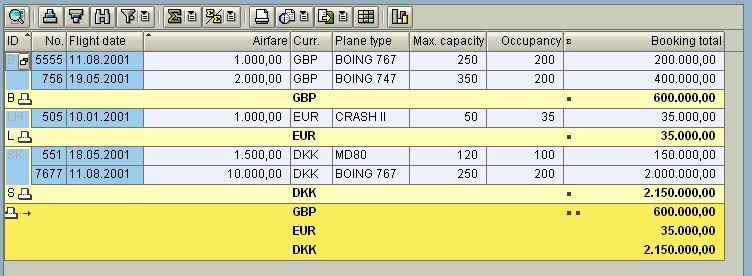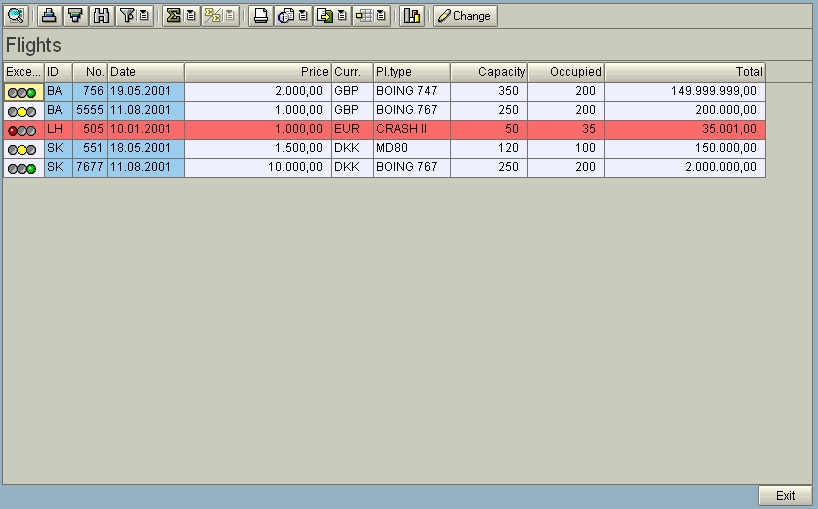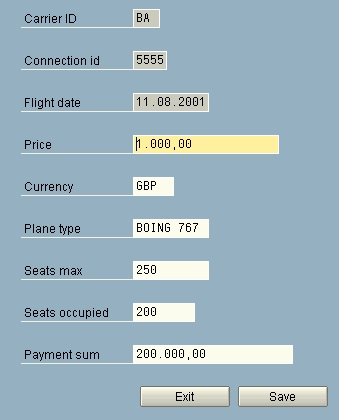
Examples
Simple
example of how to implement an ALV grid
Complete
code for the ALV grid example
Howto
Allow
the user to save and reuse the layout
Integrate
user defined functions in the grid toolbar
Set focus to
the grid
Set the
title of the grid
Customize
the appearence of the grid
Setting
and getting selected rows (Columns) and read line contents
Make
an Exception field ( = Traffic lights)
Color a line
Refresh grid
display
Example of the fdisplay of an ALV grid:

Steps:
REPORT sapmz_hf_alv_grid . TABLES: zsflight. *-------------------------------------------------------------------- * G L O B A L I N T E R N A L T A B L E S *-------------------------------------------------------------------- DATA: gi_sflight TYPE STANDARD TABLE OF sflight. *-------------------------------------------------------------------- * G L O B A L D A T A *-------------------------------------------------------------------- DATA: ok_code LIKE sy-ucomm, g_wa_sflight LIKE sflight. * Declare reference variables to the ALV grid and the container DATA: go_grid TYPE REF TO cl_gui_alv_grid, go_custom_container TYPE REF TO cl_gui_custom_container. *-------------------------------------------------------------------- * S T A R T - O F - S E L E C T I O N. *-------------------------------------------------------------------- START-OF-SELECTION. SET SCREEN '100'. *&---------------------------------------------------------------------* *& Module USER_COMMAND_0100 INPUT *&---------------------------------------------------------------------* MODULE user_command_0100 INPUT. CASE ok_code. WHEN 'EXIT'. LEAVE TO SCREEN 0. ENDCASE. ENDMODULE. " USER_COMMAND_0100 INPUT *&---------------------------------------------------------------------* *& Module STATUS_0100 OUTPUT *&---------------------------------------------------------------------* MODULE status_0100 OUTPUT. * Create objects IF go_custom_container IS INITIAL. CREATE OBJECT go_custom_container EXPORTING container_name = 'ALV_CONTAINER'. CREATE OBJECT go_grid EXPORTING i_parent = go_custom_container. PERFORM load_data_into_grid. ENDIF. ENDMODULE. " STATUS_0100 OUTPUT *&---------------------------------------------------------------------* *& Form load_data_into_grid *&---------------------------------------------------------------------* * text *----------------------------------------------------------------------* * --> p1 text * <-- p2 text *----------------------------------------------------------------------* FORM load_data_into_grid. * Read data from table SFLIGHT SELECT * FROM zsflight INTO TABLE gi_sflight. * Load data into the grid and display them CALL METHOD go_grid->set_table_for_first_display EXPORTING i_structure_name = 'SFLIGHT' CHANGING it_outtab = gi_sflight. ENDFORM. " load_data_into_grid
See also example in SAP standard program BCALV_GRID_09.
To do this use the parameters IS_VARIANT and I_SAVE of the set_table_for_first_display method. Note that the IS_VARIANT parameter must have the structure DISVARIANT.
The I_SAVE "Options for saving layouts" parameter can have the following values:
FORM load_data_into_grid. DATA: * For parameter IS_VARIANT l_layout TYPE disvariant.
Code..........
* Load data into the grid and display them l_layout-report = sy-repid. CALL METHOD go_grid->set_table_for_first_display EXPORTING i_structure_name = 'SFLIGHT' is_variant = l_layout i_save = 'A' CHANGING it_outtab = gi_
See also example in SAP standard program BCALV_GRID_05
1) To get access to the icons insert the following statement in the top of the program:
TYPE-POOLS: icon.
2) To allow the declaration
of o_event_receiver before the lcl_event_receiver class is defined, declare
it as deferred in the
start of the program
* To allow the declaration
of o_event_receiver before the lcl_event_receiver class is defined, declare
it as deferred in the
* start of the program
CLASS lcl_event_receiver DEFINITION DEFERRED.
3) Declare reference to the event handler class
DATA: o_event_receiver TYPE REF TO lcl_event_receiver.
4) Class for event receiver. This class adds the new button to the toolbar and handles the event when the button is pushed
CLASS lcl_event_receiver DEFINITION. PUBLIC SECTION. METHODS: handle_toolbar FOR EVENT toolbar OF cl_gui_alv_grid IMPORTING e_object e_interactive, handle_user_command FOR EVENT user_command OF cl_gui_alv_grid IMPORTING e_ucomm. ENDCLASS. *---------------------------------------------------------------------* * CLASS lcl_event_receiver IMPLEMENTATION *---------------------------------------------------------------------* CLASS lcl_event_receiver IMPLEMENTATION. METHOD handle_toolbar. * Event handler method for event toolbar. CONSTANTS: * Constants for button type c_button_normal TYPE i VALUE 0, c_menu_and_default_button TYPE i VALUE 1, c_menu TYPE i VALUE 2, c_separator TYPE i VALUE 3, c_radio_button TYPE i VALUE 4, c_checkbox TYPE i VALUE 5, c_menu_entry TYPE i VALUE 6. DATA: ls_toolbar TYPE stb_button. * Append seperator to the normal toolbar CLEAR ls_toolbar. MOVE c_separator TO ls_toolbar-butn_type.. APPEND ls_toolbar TO e_object->mt_toolbar. * Append a new button that to the toolbar. Use E_OBJECT of * event toolbar. E_OBJECT is of type CL_ALV_EVENT_TOOLBAR_SET. * This class has one attribute MT_TOOLBAR which is of table type * TTB_BUTTON. The structure is STB_BUTTON CLEAR ls_toolbar. MOVE 'CHANGE' TO ls_toolbar-function. MOVE icon_change TO ls_toolbar-icon. MOVE 'Change flight' TO ls_toolbar-quickinfo. MOVE 'Change' TO ls_toolbar-text. MOVE ' ' TO ls_toolbar-disabled. APPEND ls_toolbar TO e_object->mt_toolbar. ENDMETHOD.
METHOD handle_user_command. * Handle own functions defined in the toolbar CASE e_ucomm. WHEN 'CHANGE'. LEAVE TO SCREEN 0. ENDCASE. ENDMETHOD. ENDCLASS.
5) In the PBO module, crate object for event handler and set handler
CREATE OBJECT o_event_receiver. SET HANDLER o_event_receiver->handle_user_command FOR go_grid. SET HANDLER o_event_receiver->handle_toolbar FOR go_grid.
6) In the PBO module after the CALL METHOD go_grid->set_table_for_first_display, raise event toolbar to show the modified toolbar
CALL METHOD go_grid->set_toolbar_interactive.
CALL METHOD cl_gui_control=>set_focus EXPORTING control = go_grid.
Note that the structure lvc_s_layo can be used for to customize the grid appearance in many ways.
DATA:
* ALV control: Layout structure
gs_layout TYPE lvc_s_layo.
* Set grid title gs_layout-grid_title = 'Flights'. CALL METHOD go_grid->set_table_for_first_display EXPORTING i_structure_name = 'SFLIGHT' is_layout = gs_layout CHANGING it_outtab = gi_sflight.
Fill the apporpiate fields of structure lvc_s_layo and insert it as a parametrer in the CALL METHOD go_grid->set_table_for_first_display. See the example under Set the title of the grid.
If you want to change apperance after list output, use the methods get_frontend_layout and set_frontend_layout.
Examples of fields in structure lvc_s_layo:
GRID_TITLE Setting the title of the grid
SEL_MODE. Selection mode, determines how rows can be selected. Can have the follwing values:
Note that the grid table always has the rows in the same sequence as displayed in the grid, thus you can use the index of the selected row(s) to read the information in the rows fronm the table. In the examples below the grid table is named gi_sflight.
Data declaratrion:
DATA:
* Internal table for indexes
of selected rows
gi_index_rows TYPE lvc_t_row,
* Information about 1 row
g_selected_row LIKE lvc_s_row.
Example 1: Reading index of selected row(s) and using it to read the grid table
CALL METHOD go_grid->get_selected_rows IMPORTING et_index_rows = gi_index_rows.
DESCRIBE TABLE gi_index_rows LINES l_lines.
IF l_lines = 0. CALL FUNCTION 'POPUP_TO_DISPLAY_TEXT' EXPORTING textline1 = 'You must choose a valid line'. EXIT. ENDIF. LOOP AT gi_index_rows INTO g_selected_row. READ TABLE gi_sflight INDEX g_selected_row-index INTO g_wa_sflight. ENDIF. ENDLOOP.Example 2: Set selected row(s).
DESCRIBE TABLE gi_index_rows LINES l_lines. IF l_lines > 0. CALL METHOD go_grid->set_selected_rows exporting it_index_rows = gi_index_rows. ENDIF.
Example
TYPES: BEGIN OF st_sflight. INCLUDE STRUCTURE zsflight. TYPES: traffic_light TYPE c.
´TYPES: END OF st_sflight. TYPES: tt_sflight TYPE STANDARD TABLE OF st_sflight.
DATA: gi_sflight TYPE tt_sflight.
* Set the exception field of the table LOOP AT gi_sflight INTO g_wa_sflight. IF g_wa_sflight-paymentsum < 100000. g_wa_sflight-traffic_light = '1'. ELSEIF g_wa_sflight-paymentsum => 100000 AND g_wa_sflight-paymentsum < 1000000. g_wa_sflight-traffic_light = '2'. ELSE. g_wa_sflight-traffic_light = '3'. ENDIF. MODIFY gi_sflight FROM g_wa_sflight. ENDLOOP.
* Name of the exception field (Traffic light field) gs_layout-excp_fname = 'TRAFFIC_LIGHT'.
* Grid setup for first display CALL METHOD go_grid->set_table_for_first_display EXPORTING i_structure_name = 'SFLIGHT' is_layout = gs_layout CHANGING it_outtab = gi_sflight.
* To color a line the structure of the table must include a Char 4 field for color properties TYPES: BEGIN OF st_sflight. INCLUDE STRUCTURE zsflight. * Field for line color types: line_color(4) type c. TYPES: END OF st_sflight.
TYPES: tt_sflight TYPE STANDARD TABLE OF st_sflight.
DATA: gi_sflight TYPE tt_sflight.
* Loop trough the table to set the color properties of each line. The color properties field is * Char 4 and the characters is set as follows: * Char 1 = C = This is a color property * Char 2 = 6 = Color code (1 - 7) * Char 3 = Intensified on/of = 1 = on * Char 4 = Inverse display = 0 = of LOOP AT gi_sflight INTO g_wa_sflight. IF g_wa_sflight-paymentsum < 100000. g_wa_sflight-line_color = 'C610'. ENDIF. MODIFY gi_sflight FROM g_wa_sflight. ENDLOOP.
* Name of the color field gs_layout-info_fname = 'LINE_COLOR'.
* Grid setup for first display CALL METHOD go_grid->set_table_for_first_display EXPORTING i_structure_name = 'SFLIGHT' is_layout = gs_layout CHANGING it_outtab = gi_sflight.
Example:
CALL METHOD go_grid->refresh_table_display.
The example shows:


The code:
REPORT sapmz_hf_alv_grid . * Type pool for icons - used in the toolbar TYPE-POOLS: icon. TABLES: zsflight. * To allow the declaration of o_event_receiver before the * lcl_event_receiver class is defined, decale it as deferred in the * start of the program CLASS lcl_event_receiver DEFINITION DEFERRED. *-------------------------------------------------------------------- * G L O B A L I N T E R N A L T A B L E S *-------------------------------------------------------------------- *DATA: gi_sflight TYPE STANDARD TABLE OF sflight. * To include a traffic light and/or color a line the structure of the * table must include fields for the traffic light and/or the color TYPES: BEGIN OF st_sflight. INCLUDE STRUCTURE zsflight. * Field for traffic light TYPES: traffic_light TYPE c. * Field for line color types: line_color(4) type c. TYPES: END OF st_sflight. TYPES: tt_sflight TYPE STANDARD TABLE OF st_sflight. DATA: gi_sflight TYPE tt_sflight. *-------------------------------------------------------------------- * G L O B A L D A T A *-------------------------------------------------------------------- DATA: ok_code LIKE sy-ucomm, * Work area for internal table g_wa_sflight TYPE st_sflight, * ALV control: Layout structure gs_layout TYPE lvc_s_layo. * Declare reference variables to the ALV grid and the container DATA: go_grid TYPE REF TO cl_gui_alv_grid, go_custom_container TYPE REF TO cl_gui_custom_container, o_event_receiver TYPE REF TO lcl_event_receiver. DATA: * Work area for screen 200 g_screen200 LIKE zsflight. * Data for storing information about selected rows in the grid DATA: * Internal table gi_index_rows TYPE lvc_t_row, * Information about 1 row g_selected_row LIKE lvc_s_row. *-------------------------------------------------------------------- * C L A S S E S *-------------------------------------------------------------------- CLASS lcl_event_receiver DEFINITION. PUBLIC SECTION. METHODS: handle_toolbar FOR EVENT toolbar OF cl_gui_alv_grid IMPORTING e_object e_interactive, handle_user_command FOR EVENT user_command OF cl_gui_alv_grid IMPORTING e_ucomm. ENDCLASS. *---------------------------------------------------------------------* * CLASS lcl_event_receiver IMPLEMENTATION *---------------------------------------------------------------------* CLASS lcl_event_receiver IMPLEMENTATION. METHOD handle_toolbar. * Event handler method for event toolbar. CONSTANTS: * Constants for button type c_button_normal TYPE i VALUE 0, c_menu_and_default_button TYPE i VALUE 1, c_menu TYPE i VALUE 2, c_separator TYPE i VALUE 3, c_radio_button TYPE i VALUE 4, c_checkbox TYPE i VALUE 5, c_menu_entry TYPE i VALUE 6. DATA: ls_toolbar TYPE stb_button. * Append seperator to the normal toolbar CLEAR ls_toolbar. MOVE c_separator TO ls_toolbar-butn_type.. APPEND ls_toolbar TO e_object->mt_toolbar. * Append a new button that to the toolbar. Use E_OBJECT of * event toolbar. E_OBJECT is of type CL_ALV_EVENT_TOOLBAR_SET. * This class has one attribute MT_TOOLBAR which is of table type * TTB_BUTTON. The structure is STB_BUTTON CLEAR ls_toolbar. MOVE 'CHANGE' TO ls_toolbar-function. MOVE icon_change TO ls_toolbar-icon. MOVE 'Change flight' TO ls_toolbar-quickinfo. MOVE 'Change' TO ls_toolbar-text. MOVE ' ' TO ls_toolbar-disabled. APPEND ls_toolbar TO e_object->mt_toolbar. ENDMETHOD. METHOD handle_user_command. * Handle own functions defined in the toolbar CASE e_ucomm. WHEN 'CHANGE'. PERFORM change_flight. * LEAVE TO SCREEN 0. ENDCASE. ENDMETHOD. ENDCLASS. *-------------------------------------------------------------------- * S T A R T - O F - S E L E C T I O N. *-------------------------------------------------------------------- START-OF-SELECTION. SET SCREEN '100'. *&---------------------------------------------------------------------* *& Module USER_COMMAND_0100 INPUT *&---------------------------------------------------------------------* MODULE user_command_0100 INPUT. CASE ok_code. WHEN 'EXIT'. LEAVE TO SCREEN 0. ENDCASE. ENDMODULE. " USER_COMMAND_0100 INPUT *&---------------------------------------------------------------------* *& Module STATUS_0100 OUTPUT *&---------------------------------------------------------------------* MODULE status_0100 OUTPUT. DATA: * For parameter IS_VARIANT that is sued to set up options for storing * the grid layout as a variant in method set_table_for_first_display l_layout TYPE disvariant, * Utillity field l_lines TYPE i. * After returning from screen 200 the line that was selected before * going to screen 200, should be selected again. The table gi_index_rows * was the output table from the GET_SELECTED_ROWS method in form * CHANGE_FLIGHT DESCRIBE TABLE gi_index_rows LINES l_lines. IF l_lines > 0. CALL METHOD go_grid->set_selected_rows EXPORTING it_index_rows = gi_index_rows. CALL METHOD cl_gui_cfw=>flush. REFRESH gi_index_rows. ENDIF. * Read data and create objects IF go_custom_container IS INITIAL. * Read data from datbase table PERFORM get_data. * Create objects for container and ALV grid CREATE OBJECT go_custom_container EXPORTING container_name = 'ALV_CONTAINER'. CREATE OBJECT go_grid EXPORTING i_parent = go_custom_container. * Create object for event_receiver class * and set handlers CREATE OBJECT o_event_receiver. SET HANDLER o_event_receiver->handle_user_command FOR go_grid. SET HANDLER o_event_receiver->handle_toolbar FOR go_grid. * Layout (Variant) for ALV grid l_layout-report = sy-repid. "Layout fo report *--------------------------------------------------------------- * Setup the grid layout using a variable of structure lvc_s_layo *--------------------------------------------------------------- * Set grid title gs_layout-grid_title = 'Flights'. * Selection mode - Single row without buttons * (This is the default mode gs_layout-sel_mode = 'B'. * Name of the exception field (Traffic light field) and the color * field + set the exception and color field of the table gs_layout-excp_fname = 'TRAFFIC_LIGHT'. gs_layout-info_fname = 'LINE_COLOR'. LOOP AT gi_sflight INTO g_wa_sflight. IF g_wa_sflight-paymentsum < 100000. * Value of traffic light field g_wa_sflight-traffic_light = '1'. * Value of color field: * C = Color, 6=Color 1=Intesified on, 0: Inverse display off g_wa_sflight-line_color = 'C610'. ELSEIF g_wa_sflight-paymentsum => 100000 AND g_wa_sflight-paymentsum < 1000000. g_wa_sflight-traffic_light = '2'. ELSE. g_wa_sflight-traffic_light = '3'. ENDIF. MODIFY gi_sflight FROM g_wa_sflight. ENDLOOP. * Grid setup for first display CALL METHOD go_grid->set_table_for_first_display EXPORTING i_structure_name = 'SFLIGHT' is_variant = l_layout i_save = 'A' is_layout = gs_layout CHANGING it_outtab = gi_sflight. *-- End of grid setup ------------------------------------------- * Raise event toolbar to show the modified toolbar CALL METHOD go_grid->set_toolbar_interactive. * Set focus to the grid. This is not necessary in this * example as there is only one control on the screen CALL METHOD cl_gui_control=>set_focus EXPORTING control = go_grid. ENDIF. ENDMODULE. " STATUS_0100 OUTPUT *&---------------------------------------------------------------------* *& Module USER_COMMAND_0200 INPUT *&---------------------------------------------------------------------* * text *----------------------------------------------------------------------* MODULE user_command_0200 INPUT. CASE ok_code. WHEN 'EXIT200'. LEAVE TO SCREEN 100. WHEN'SAVE'. PERFORM save_changes. ENDCASE. ENDMODULE. " USER_COMMAND_0200 INPUT *&---------------------------------------------------------------------* *& Form get_data *&---------------------------------------------------------------------* * text *----------------------------------------------------------------------* FORM get_data. * Read data from table SFLIGHT SELECT * FROM zsflight INTO TABLE gi_sflight. ENDFORM. " load_data_into_grid *&---------------------------------------------------------------------* *& Form change_flight *&---------------------------------------------------------------------* * Reads the contents of the selected row in the grid, ans transfers * the data to screen 200, where it can be changed and saved. *----------------------------------------------------------------------* FORM change_flight. DATA:l_lines TYPE i. REFRESH gi_index_rows. CLEAR g_selected_row. * Read index of selected rows CALL METHOD go_grid->get_selected_rows IMPORTING et_index_rows = gi_index_rows. * Check if any row are selected at all. If not * table gi_index_rows will be empty DESCRIBE TABLE gi_index_rows LINES l_lines. IF l_lines = 0. CALL FUNCTION 'POPUP_TO_DISPLAY_TEXT' EXPORTING textline1 = 'You must choose a line'. EXIT. ENDIF. * Read indexes of selected rows. In this example only one * row can be selected as we are using gs_layout-sel_mode = 'B', * so it is only ncessary to read the first entry in * table gi_index_rows LOOP AT gi_index_rows INTO g_selected_row. IF sy-tabix = 1. READ TABLE gi_sflight INDEX g_selected_row-index INTO g_wa_sflight. ENDIF. ENDLOOP. * Transfer data from the selected row to screenm 200 and show * screen 200 CLEAR g_screen200. MOVE-CORRESPONDING g_wa_sflight TO g_screen200. LEAVE TO SCREEN '200'. ENDFORM. " change_flight *&---------------------------------------------------------------------* *& Form save_changes *&---------------------------------------------------------------------* * Changes made in screen 200 are written to the datbase table * zsflight, and to the grid table gi_sflight, and the grid is * updated with method refresh_table_display to display the changes *----------------------------------------------------------------------* FORM save_changes. DATA: l_traffic_light TYPE c. * Update traffic light field * Update database table MODIFY zsflight FROM g_screen200. * Update grid table , traffic light field and color field. * Note that it is necessary to use structure g_wa_sflight * for the update, as the screen structure does not have a * traffic light field MOVE-CORRESPONDING g_screen200 TO g_wa_sflight. IF g_wa_sflight-paymentsum < 100000. g_wa_sflight-traffic_light = '1'. * C = Color, 6=Color 1=Intesified on, 0: Inverse display off g_wa_sflight-line_color = 'C610'. ELSEIF g_wa_sflight-paymentsum => 100000 AND g_wa_sflight-paymentsum < 1000000. g_wa_sflight-traffic_light = '2'. clear g_wa_sflight-line_color. ELSE. g_wa_sflight-traffic_light = '3'. clear g_wa_sflight-line_color. ENDIF. MODIFY gi_sflight INDEX g_selected_row-index FROM g_wa_sflight. * Refresh grid CALL METHOD go_grid->refresh_table_display. CALL METHOD cl_gui_cfw=>flush. LEAVE TO SCREEN '100'. ENDFORM. " save_changes